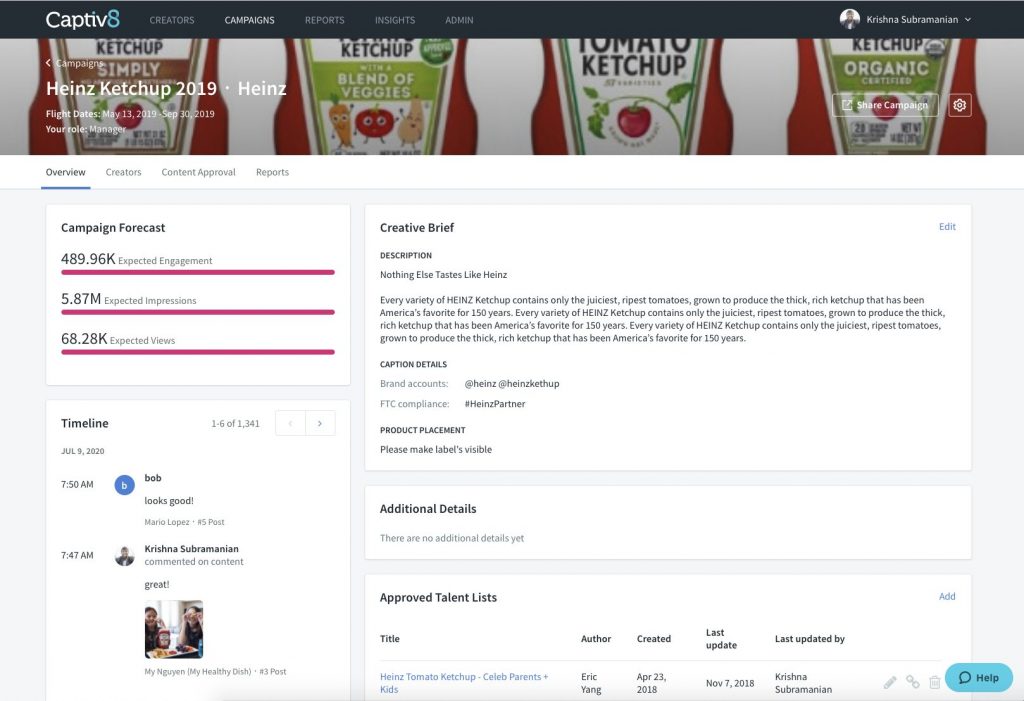Captiv8 was founded in 2015, and three of its four founders had ties that go back even further than that. In 2008, Krishna Subramanian, Sunil Verma, and Vishal Gurbaxani had their first crack at a digital advertising startup with their company Mobclix. It was essentially an ad exchange for freeware app developers. The iPhone was about a year old and the app store really started to take off and app makers could fund their development this way.
A good idea at the right time, Mobclix proved to be very successful. By 2010, the trio had sold their company to Velti, working their for a time until they wanted to do something new. Influencer marketing didn’t yet have a name when the three of them identified the opportunities that lay ahead on social media—and Instagram in particular. Captiv8 was born, but initially only has a social listening and analytics tool. They were able to amass a huge amount of data on the digital celebrities that started appearing on Instagram, and began shopping the tool to talent agencies around Los Angeles.
The agencies were initially reluctant but as influencer marketing eventually became a thing they couldn’t ignore, so, too, did the data that Captiv8 could provide. The agencies that the team had first pitched start returning their calls, and soon Captiv8 was providing its listening and data services to almost 80% of the top 30 talent agencies in the world. William Morris and CAA are clients. United Talent Agency is an investor. It wasn’t long before the large brands, the kinds with their own robust marketing departments wanted in on this data, too.
Over the years, Captiv8 added features to the platform such that it is now an end-to-end influencer marketing platform. The social listening feature is still prominent, and the AI is always working to catalog any bit of data it can see about the 1.5 million+ influencer in its database. Because Captiv8 has marketing and/or API partnerships with all of the social channels, their data gets to some very deep levels. But Captiv8 has rounded out the offering with Discovery, Campaign Management, and a Reporting/Analytics component—all of which combine to make it a top of the line platform and a standout in its class.
Along with nearly all the top talent agencies, Captiv8 also boasts an impressive list of brands as its customer base. Honda, Dr. Pepper, Fox, Nissan, and Miller Lite, among others, rely on Captiv8 to power their influencer marketing efforts. It’s no surprise that the team behind this platform got it so right. Their past success—both in identifying an opportunity and executing on it—was fueled by each of the founders backgrounds in digital advertising, not software. The same dynamic is at work here, all of which you can see in the details of Captiv8 (and: The Details, below).
Summary:
Pricing
As with any high end software, whether it’s in the cloud or on your own hardware, pricing is a highly custom affair. Captiv8 is in the cloud, but still at the high end: their target customer is large agencies and brands, exclusively. You can imagine, then, that everything about pricing and services is going to be customised to the clients needs, from the features they use to how many users they need to support.
The Details
Because social listening, and the AI engine behind it, constitutes the foundation of Captiv8, let’s have a look at that first. Above all else, social listening is a research tool, and the platform allows you to research one of three categories: accounts, hashtags, and location. For each of these the amount of different data sets you’re presented with is staggering.
Search by account, and you’ll get a deep dive into it and its audience. You’ll find out more about things like the audience—basics like age/gender/location demographics, but you’ll get to understand exactly when they’re most active. You’ll see when and what they’re posting, how their content performs. There’s data on engagement, of course—not just the raw metrics but the days and times engagement was highest, along with an hour-by-hour performance assessment of the first 24 hours after a post goes live. All this information isn’t just for your consumption; if you activate an influencer into a campaign, the platform will make recommendations on the best times to post.
Searching hashtags yields just as thorough an amount of data, albeit from another perspective. Here you’ll learn exactly who’s using the hashtag, and to what degree of effectiveness. You can find out contributors’ age, their gender, where they are—then go deeper and find out the hashtag performs in other kinds of demographic groups, like ethnicity, income, religion, and language spoken. You’ll also see the interests of the contributors broken out into around two dozen categories, like Real Estate, Fasion, Travel, or Shopping.The full list of every data point available on Captiv8 icannot be relayed here completely, and so it’s enough to say that users of the platform are not going to be left wanting for more information.
With all that data sitting there, it’s not surprising that the Discovery feature is just as in-depth. You can, of course, do a regular search where you specify a keyword and refine your results based on other traits. More useful than that is the ability to search by audience characteristics, from gender to interests to companies they’ve mentioned. But even more useful is searching by content. The AI digests all the content influencers produce and is able to label and categorize them, such that they can be searchable by topic. You can then further filter down by brand affinity, for example, and you’ll not only get results showing you people who’ve mentioned the brand, but also a score showing their overall sentiment, At every turn with Captiv8 there are little deep dives into the data like this, things you wouldn’t have thought you needed to know but you can’t do without now that you know them.
The discovery database has over 1.5 million profiles indexed, profiles which the AI deems to be high quality and influential. If you’re already working with influencers and they haven’t already been indexed into Captiv8, you can easily add them in from the platform. They’ve also made an excellent Chrome extension: if you’re looking at someone’s profile on the web, you can click the extension. If they’re in the database, you can go right to their profile to get at all their information. But if they’re not, you can import them right from the extension and all their data gets ingested into the platform.
As you wade through influencer profiles you can keep them organized in a talent list. You can have multiple talent lists, group them however you like, and each one acts as a kind of mini-CRM. Team members can collaborate on the curation and maintenance of the lists, leave notes about influencers featured in there, attach documents to each profile. The most sensible use for the talent list is to organize influencers by the campaign you want them for. When you’ve moved on to campaign management, all you need to do is import this list into the campaign brief and all the influencers who’ve been approved are automatically added to the list.
Often, a platform will advertise how it takes a very small amount of time to setup a campaign brief as a measure of how easy their software is to use. Hell, we’re guilty of saying that in these reviews. Setting up a campaign on Captiv8 dispels the notion that faster is better. Not that it takes very long to do it here, either: it just takes longer than other platforms. And that’s a good thing. It means that Captiv8 is thorough, and everything you’ll need to have figured out for the campaign needs to be figured out ahead of time. Your brief and your talent list, yes, but also your contracts (made easier by using contract templates). You’ll need to set up all your payment details, and you’ll need to precisely define the deliverables expected before those payments are made. If you’re an agency, you have the ability to wall off the creators from your clients and maintain tighter controls over communication. Filling out the campaign brief is in-depth enough that they should maybe reconsider calling it a brief. But all this is attention to detail ensures that once the content starts rolling in, that’s all you need to worry about. Everything else is automated.
The final part of The Details covers the reporting, and you can probably see where this is going. Yes, it’s excellent. It would have been more interesting to tell you that Captiv8 just gave up when they hit reporting so you just get the same pie chart no matter what you do. That would have at least been surprising. But, no, the reporting and campaign measurement features are excellent. You start from a bird’s-eye view to see the basic stats—how many creators, how many posts, the reach, engagement, reach and engagement broken down by organic vs paid, engagement by platform, top performing posts and creators, sentiment analysis and more.
It goes deeper than that, though, getting into the details of the audiences you reached and the influencers who performed the best for you, going into their individual posts and performance for your review, and you can filter all this information to show only the information that’s relevant to to you.
Conclusion
The reviews here at IMH are a purposefully curated batch of the best influencer software on offer today. We’ve seen awful software and rejected their inclusion here. We’ve seen excellent software and told you about those. Every so often we see one that rises above the rest in blatant and obvious ways, and Captiv8 is the most recent platform to have this effect.
The review itself is frustrating to write, because it’s difficult, if not impossible, to express just how complete Captiv8 is. The team behind its creation have a long history with digital advertising and it shows in this software. There’s no feature that isn’t included, no implementation of a feature that isn’t up to snuff. This is software that’s both of its time and ahead of it.
Captiv8
-
Features
-
Ease of Use
-
Reporting





